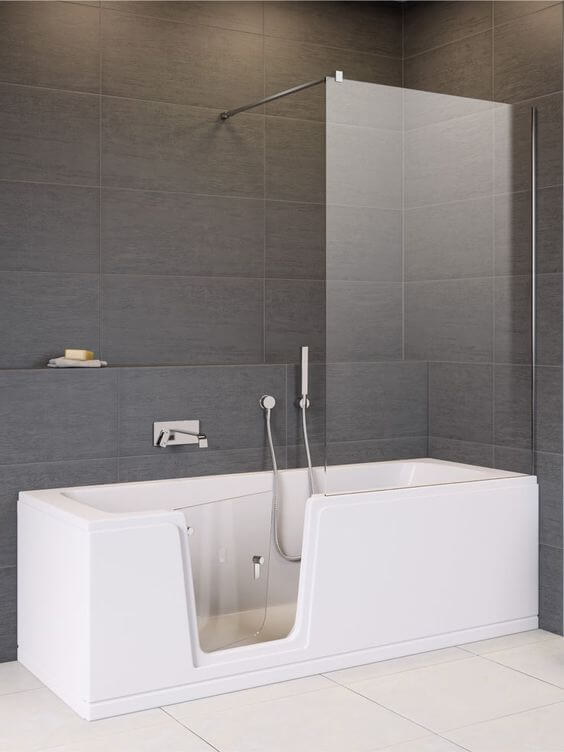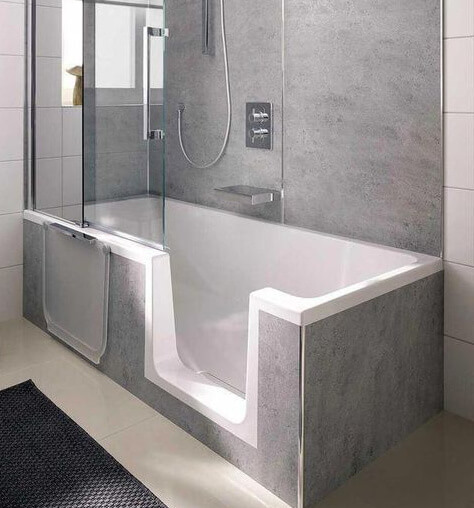Are you doing a walk in tubs project?
Modernize can pair you with three to four pros in your area, so you can compare options and save time and money.
As we get older, the thought of going into an assisted living facility might cross your mind – but for most people, it’s something they dismiss rather quickly. According to the AARP, 77% of those aged 50 and older want to stay in their own homes for as long as possible. A survey from Aging in Place found that 90% of senior homeowners intend to stay in their homes for the next five to ten years, and 85% of them believe they can stay in their homes without significant home modifications.
But what home modifications would it take to keep a person at home for longer, as opposed to going into an assisted living facility? It’s important to know what it might take to help ensure that your loved one can stay in their home for as long as possible. Knowing what modifications will be necessary can help everyone in making the right decision for comfort, safety, and peace of mind.

The Benefits of an Assisted Living Facility
Before we dive into the potential home modifications that could help your loved one stay home longer, let’s look at the possibility of moving to an assisted living facility. When does this make more sense?
If your loved one needs specialized care or around-the-clock monitoring, an assisted living facility might be a good bet. Even if your loved one can get around just fine, there are other points to consider. For instance, do they need a specialized diet? If so, can they afford it? If they are at an assisted living facility, accommodating their diet can be easily handled by the cafeteria staff and it’s inclusive, so there is no additional fee. If your loved one lives alone right now and feels isolated, or if they need the assistance of several people to manage their life – such as a professional caretaker, housekeeper, and driver for those who can no longer get behind the wheel – it makes sense to go with a facility that offers all of that and more. However, there is a hefty price tag for all that care. The average monthly cost for an assisted living facility is $3,750.
Can Your Loved One Really Stay at Home?
Aging in place has many advantages, but it also has a price tag to consider. Basic home modifications – such as installing grab bars, sturdy handrails, lowering countertops, installing lever-handled door knobs, or even improving the lighting can add up to $10,000 or so. More expensive renovations, such as building a ramp, installing a roll-in shower or walk-in tub, widening hallways, and other renovations that take the experience of a contractor, can run up to $100,000.
Once that’s done, hiring a visiting professional caregiver can run about $4,000 per month – a comparable price to that of an assisted living facility. Given that, if you can afford the up-front cost of home modifications, staying at home and being independent for longer is certainly possible for your loved one. And keep in mind, there are ways to make home modifications more affordable, especially if you just focus on what you really need.
The Right Home Modifications for Aging in Place
What exactly does your loved one need to gracefully age in place? That depends on their situation, the layout of their home, and the budget. Here are some of the basics you might need.
Widen the Doorways
If your loved one is in a wheelchair, this is a home modification that really can’t wait if you want your loved one to be able to access all parts of their home. But it is also a good idea well before anyone gets to the point of needing a mobility aid like a walker or wheelchair. Wider doorways make it easier for anyone to move around the home, and they can come in especially handy when you need to move furniture in and out of a room, such as replacing the typical bed with a hospital bed.
Find the Right Contractor for Your Walk In Tubs Project
Whether you’re ready to begin your project now or need some expert advice, our network of contractors are here to help. With a few simple questions, we’ll find the best local professionals for you
Install a Walk-in Tub or a Roll-in Shower
A typical bathtub might not work well for someone getting older, so consider switching to a walk-in tub. This tub will almost always fit into the same space as the existing tub but will provide much safer entry and exit, as well as the possibility of deeper soaking and thus, better hygiene. Those who are in a wheelchair can make great use of a roll-in shower that allows them to enjoy the shower without having to worry about how they are going to get in and out of it. A bench in the shower is also a boon for anyone in the home, regardless of how well they can get around.
Invest in Grab Bars
These are vitally important and can be helpful for anyone, especially in the bathroom around the shower or tub. Grab bars can help prevent slips and falls and the consequences that can come from that – studies have shown that falls are more serious for the elderly than they are for younger people, and the risk of dying from a fall goes up as one ages. Grab bars can work well outside of the tub or shower as well. Consider putting them near the toilet, close to the bed in a bedroom for help in standing up at night, and anywhere there might be a trip hazard, such as near a set of two or three steps in a split-level home. A good contractor can help you figure out the best places for grab bars. Make sure the grab bars are rated for your loved one’s weight/size.
Install Ramps
Ramps over any outdoor steps and over small sets of steps inside the house are always a good idea, even if your loved one doesn’t use a wheelchair. Ramps are much easier to navigate than stairs. A good contractor is aware of the ideal height and rise of an outdoor ramp and can configure it properly, even if it needs to wrap around the house or double-back on itself to make it work in a smaller space. Indoor ramps over thresholds provide a smooth transition from one room to another. Some indoors ramps can be installed by yourself, but to be sure that you’re getting the safest option, consult a contractor.
Make the Kitchen Friendlier
For those who need to be in a seated position for cooking, adjusting the height of the countertops and sink is a great idea. Look for appliances that offer easy use for those in a wheelchair, such as those that have controls on the front rather than the back, or ovens that sit in a cabinet at just the right height. You can also move light switches and outlets to better accommodate someone with limited reach. Consider pull-out shelves in the cabinets to make it easier to reach things – this is a great help for anyone in the home, regardless of mobility. Even replacing your faucet with a hands-free option will make life much easier for everyone. These modifications can be rather expensive, so take care to work with a contractor to stay well within your budget.
Install a Stairlift
A stairlift makes it much easier to go up and down the staircase of your home. Simply sit down in the seat, buckle in, and use the built-in controls to make the seat rise up to the top of the staircase or glide smoothly to the bottom, where you can then safely dismount the seat at the landing. A stairlift can be especially helpful for those who want to continue with their usual routine of laundry and the like, as the seated position allows them to easily carry a basket or other item up the stairs with them with no risk of falling. Stairlifts can be attached as a temporary measure or permanent one. Talk with your contractor about the best options and configurations.
Invest in a Medical Alert System
Medical alert devices have come a long way since the “I’ve fallen and I can’t get up” commercials on late-night television. Today, these devices still allow you to call for help at the touch of a button, but they are much more streamlined, attractive, and versatile. In addition to an alert pendant or wristwatch, you can also go with whole-home systems that include video monitoring, so you can look in on your loved one and make sure they are alright.
All of these modifications can be handled by a contractor who is well-versed in solutions for aging in place. These home modifications can run from quite affordable to rather expensive, but a contractor can help you work within your budget and determine the most necessary changes to help your loved one age in place and stay independent for as long as possible. To help you plan, check out our home accessibility checklist.
Find the Right Contractor for Your Walk In Tubs Project
Whether you’re ready to begin your project now or need some expert advice, our network of contractors are here to help. With a few simple questions, we’ll find the best local professionals for you
Reviews from Real Homeowners
Welcome to Homeowner Resources! We are the Modernize blog. Modernize pairs more than 3 million homeowners a year with pre-vetted contractors in their area. This blog started because we believe homeowners should know everything about their homes, from how their HVAC works to which front door colors they might love. On Homeowner Resources, you can find information on every part of your home, right down to how you can negotiate with contractors to get the best price. Here's more about the blog.
Need a contractor? Learn more about how Modernize finds the right pro for you.



